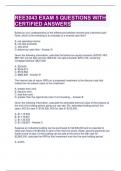REE3043 EXAM 5 QUESTIONS WITH
CERTIFIED ANSWERS
Based on your understanding of the differences between levered and unlevered cash
flows, which of the following is an example of a levered cash flow?
A. net operating income
B. net sale proceeds
C. sale price
D. before-tax cash flow - Answer-D
Given the following information, calculate the before-tax equity reversion (BTER): NOI:
$89,100; annual debt service: $58,444; net sale proceeds: $974,700; remaining
mortgage balance: $631,026.
A. $30,656
B. $343,674
C. $572,582
D. $885,600 - Answer-B
The internal rate of return (IRR) on a proposed investment is the discount rate that
makes the net present value of the investment
A. greater than zero.
B. equal to zero.
C. less than zero.
D. greater than the opportunity cost of not investing. - Answer-B
Given the following information, calculate the estimated terminal value of the property at
the end of its holding period: going-out cap rate: 9%; estimated holding period: five
years; NOI for year 5: $100,500; NOI for year 6: $102,000.
A. $1,113,333
B. $1,116,667
C. $1,133,333
D. $1,166,667 - Answer-C
Suppose an industrial building can be purchased for $2,500,000 and is expected to
yield cash flows of $180,000 in each of the next five years. (Note: assume payments are
made at end of year.) If the building can be sold at the end of the fifth year for
$2,800,000, calculate the IRR for this investment over the five-year holding period.
A. 0.09%
, B. 4.57%
C. 9.20%
D. 10.37% - Answer-C
In discounted cash flow (DCF) analysis, the sale price of the property must be estimated
at the end of the expected holding period. The most common method for determining
the terminal value of the property is the
A. yield capitalization method.
B. direct capitalization method.
C. repeat-sales approach.
D. cost approach. - Answer-B
Given the following expected cash flow stream, determine the NPV of the proposed
investment in an income producing property and determine whether or not the
investment should be pursued: investment horizon: five years; expected yearly cash
flow in each of the next five years: $127,628; expected sale price at end of five years:
$1,595,350; opportunity cost of investment 6%; current market price of property:
$1,750,000.
A. NPV is -$20,246; decision is to invest.
B. NPV is -$20,246; decision is not to invest.
C. NPV is $249,967; decision is to invest.
D. NPV is $249,967; decision is to not invest. - Answer-B
The use of financial leverage when investing in real estate is a double-edged sword.
While increased leverage may allow the investor to "purchase" higher expected returns,
the "price" of doing so is an increase in which of the following risks?
A. liquidity risk
B. default risk
C. interest rate risk
D. pipeline risk - Answer-B
In discounted cash flow analysis, the industry standard for pro forma cash flow
projections of investment properties is typically
A. 3 years.
B. 5 years.
C. 10 years.
D. 15 years. - Answer-C
Given the following information regarding an income-producing property, determine the
after tax internal rate of return (IRR): expected holding period: five years; 1st year
expected BTCF: $30,656; 2nd year expected BTCF: $33,329; 3rd year expected BTCF:
$36,082; 4th year expected BTCF: $38,918; 5th year expected BTCF: $41,839; 1st year




